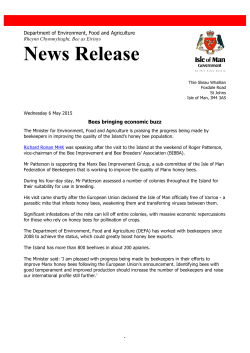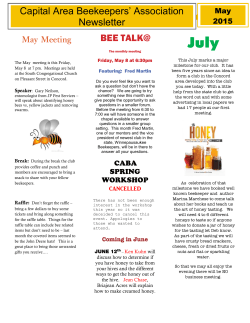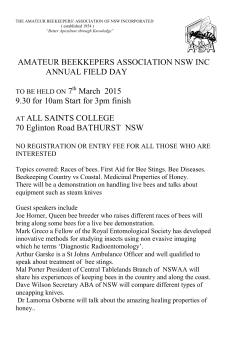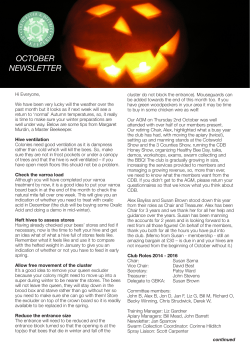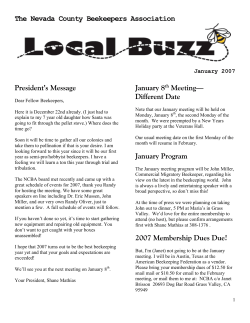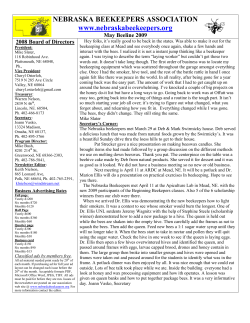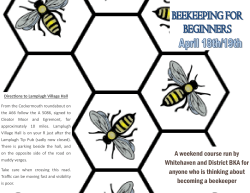
here - Australian Honey Bee Industry Council
THE AUSTRALIAN HONEY BEE INDUSTRY BIOSECURITY CODE OF PRACTICE A SUMMARY The Objectives of the Code The Australian Honey bee Industry Biosecurity Code of Practice (the Code) has been developed in consultation with beekeepers and governments to provide a clear framework for Australian beekeepers to engage in best-practice biosecurity. The objectives of the Code are to: Increase productivity in the Australian honey bee industry by improving the general level of disease and pest control by Australian beekeepers. Assist beekeepers in recognising exotic pests and diseases of bees and preparation for an exotic or emerging disease response. Ensure beekeepers conduct regular surveillance for the presence of notifiable exotic and endemic pests and diseases. Assist in the management of significant endemic diseases of bees, particularly American foulbrood (AFB). Facilitate the cross-border movement of bees through adoption of a single national code for biosecurity practices. To ensure the future viability and sustainability of the Australian honey bee industry. The Code underpins the National Bee Biosecurity Program and is based on the principles of good biosecurity. It describes the outcomes a beekeeper needs to achieve for good pest and disease prevention and control. It is not a manual on how to keep bees; the Code tells beekeepers what they must achieve but how they achieve it will be up to the individual and will be influenced by their situation. The standards set in the Code are only those things that all beekeepers should be doing to minimise the impact of pests and diseases on their own hives and those of their fellow beekeepers. State and Territory Legislation Takes Precedence Over the Code All states and territories have legislation applying to beekeepers and the practice of beekeeping. The Code does not replace this state or territory legislation but is complementary to it. For the most part, the Code aligns with state and territory legislations but this is not always possible. Where the Code contradicts local state or territory legislation, the state or territory legislation takes precedence. Australian Honey Bee Industry Biosecurity Code of Practice DRAFT 1.13 – 7/05/15 Page 1 THE REQUIREMENTS FOR ALL BEEKEEPERS 1. Beekeepers Must Be Registered There are many reasons why an accurate register of beekeepers and hive numbers is needed. These include notification of beekeepers in the event of a natural disaster like a bushfire and deployment of resources to combat an exotic disease outbreak. Registration is already compulsory in all jurisdictions except Tasmania, the ACT and the NT. The Code notes that where law requires it, all beekeepers must register with their relevant state or territory authority and pay the prescribed fee (if any) set by that authority. At the time of registration, in addition to other details required by the registering authority, the beekeeper must provide an accurate count of the number of hives under the beekeeper’s control. The Australian honeybee industry will continue to work with all governments to implement a nationally consistent, mandatory registration system in all states and territories. 2. Beekeepers Must Report Notifiable Diseases The requirement to report detection or suspicion of notifiable diseases is already legislated in all states and territories. To reinforce this very important obligation, the Code also stipulates that a beekeeper must have knowledge of the pests and diseases that are notifiable in the state or territory where their hives are located and must report the detection or suspicion of any notifiable disease to their relevant state or territory authority by the quickest practicable means. Verbal reports should be followed up in writing (for example, by e-mail, text message (SMS), fax or letter). 3. Hives Must be Regularly Inspected for Significant Pests and Diseases The Code requires all beekeepers to examine each apiary under their control by visually inspecting each hive for general hive strength and for the presence of pests and diseases. These inspections must be carried out at least twice per year (no less than 4 months apart) and in a manner that will enable likely detection of any visual evidence of a pest or disease present in the hive. At a minimum, the inspection must include visual examination of the equivalent of three full-depth frames of brood after shaking off adult bees. Twice per year is the minimum requirement and, depending on circumstances, many beekeepers will inspect their hives more frequently. In any case, the beekeeper must inspect often enough to minimise inter-hive spread of any pest or disease and/or colony death. Surveillance for exotic mites and Braula fly is an important step in protecting the industry from these pests. In at least 2 inspections per year (at a minimum of 4 consecutive calendar months apart) at least one hive in each apiary must be examined for the presence of arthropod pests such as Varroa or Tropilaelaps mites and Braula fly using one of the following methods: Sugar shake Alcohol wash Drone uncapping Australian Honey Bee Industry Biosecurity Code of Practice DRAFT 1.13 – 7/05/15 Page 2 4. Beekeepers Must Control or Eradicate Pests and Diseases and Must Manage Weak Hives Beekeepers must take steps to reduce the impact of disease on their apiaries and have an obligation to minimise the risk of disease spread to other beekeepers’ apiaries. Therefore the Code requires a beekeeper to treat hives affected by a pest or disease in a manner that will minimise the likelihood of the pest or disease either weakening the hive or being transferring to another hive. Dead hives or hives with insufficient bees to prevent robbing by other bees must be immediately removed from the apiary and treated to rendered them impervious to robber bees and prevent leakage of honey from the hives. Weak hives must be managed to ensure they do not become attractive to robber bees. The Code has some specific requirements if American foulbrood (AFB) is found in a hive. If a beekeeper identifies AFB they must, after the field bees have returned to the hive, immediately physically identify and isolate the affected hive and any contaminated appliances and take steps to prevent the risk of spread of disease from the hive. This includes destruction of all bees in the hive and rendering and maintaining the hive and appliances bee-proof until they are cleaned, sterilised or destroyed as appropriate. In this context “bee-proof” means eliminating bee access to the affected appliances and hive contents including honey that may leak from the hive. If it is not reasonable to immediately implement these steps and the hive is not in danger of being robbed, they must be completed within seven (7) days. A beekeeper must eliminate American foulbrood from an infected hive by sterilisation (gamma radiation) or destruction as soon as is reasonable but, in any case, before sale or reuse of the hive. Appliances likely to be contaminated with American foulbrood must be scrubbed or steam cleaned to remove all traces of honey, beeswax and propolis prior to rinsing in clean water. Because antibiotics do not kill AFB spores and may mask the symptoms of the disease, the Code prohibits a beekeeper from using any antibiotic for the purposes of treating AFB in hives. 5. Beekeepers Must Maintain Records of Biosecurity-related Actions and Observations Keeping good records is a key part of any business operation, including biosecurity. The beekeepers records also provide evidence that the beekeeper has undertaken the actions required to comply with the Code. Therefore all beekeepers must keep legible records of: (a) The dates of all apiary inspections and observations from the inspections including an assessment of the overall strength of the hives in the apiary, any pests or diseases found in the hives and the method used for detection of arthropod pests specified in part 3 above. (b) Details of all actions taken to manage any pests or diseases in the apiary. (c) Details of sampling method, date(s) of collection, testing body and the results of all honey tests or other independent assessments for the presence of American foulbrood. (d) Details of movements of hives (including swarm catch boxes); including dates, numbers, geographic locations. (e) Details of introductions of any bees and used hives or hive components (with or without bees); including the date of introduction and the supplier or source. (f) Details of biosecurity-related training by the beekeeper and any employees of the beekeeper. Records may be paper-based or electronic and must be retained for a minimum of 3 years. Australian Honey Bee Industry Biosecurity Code of Practice DRAFT 1.13 – 7/05/15 Page 3 6. Hives Must be Appropriately Constructed and Branded A beekeeper must ensure that each hive (including swarm catch boxes) is manufactured and maintained so as to have intact external surfaces with bee access only permitted via specifically designed and manufactured access points. This helps bees defend the hive from robber bees. Well-constructed hives with intact walls and limited entrances are easier for bees to defend from robber bees therefore the Code stipulates that all hives must be maintained in way that allows combs to be individually and separately removed from the hive for easy inspection. Top bar hives that comply with this requirement are allowed. A hive placed for the purpose of catching bee swarms (a swarm catch box) must only contain foundation. Frames already drawn or that contain brood, honey or pollen are not permitted and would be considered to be exposed material. Each hive must be clearly and legibly marked with the beekeeper’s allocated hive identification code in accordance with relevant state or territory legislation. In addition, a hive placed for the purpose of catching bee swarms (swarm catch box) that is not on the property where the beekeeper normally resides must also be identified with the beekeeper’s name (or company name) and a contact telephone number, in characters at least 25 mm in height. 7. Beekeepers Must Not Allow Hives, or Appliances to Become Exposed or Neglected Exposed material is a potential source of infection for other bees so the Code stipulates that a beekeeper must not allow a used hive, part of a used hive (including frames, combs, honey, foundation or beeswax) or an appliance containing honey to be exposed in a manner or under conditions likely to attract robber bees; including during transportation. A beekeeper must not abandon a hive previously kept by the beekeeper, neglect the management or care of a hive kept by the beekeeper to the extent that the hive is likely to become infected with disease or attract robber bees, or fail to destroy or properly dispose of any unwanted bees or part of a hive (including frames, combs, honey, foundation or beeswax). Water is essential for healthy bees and a beekeeper must ensure bees under his or her care have access to water suitable to sustain the bees. 8. Beekeepers Must Allow Their Operation to Be Assessed Compliance with the Code will be monitored through assessment of beekeepers’ records. The industry-funded Bee Biosecurity Officer (BBO) will assess a sample of beekeepers each year. The BBO will focus on larger beekeepers (50 or more hives) but may look at smaller beekeepers if there is a problem. If a beekeeper is notified that they will be subjected to review of records the beekeeper must, comply with all reasonable requests from the Assessor for access to the beekeepers records and provide any additional information within 30 days. If the BBO thinks an assessment of the apiary is also warranted, the beekeeper must comply with all reasonable requests from the Assessor to inspect the beekeepers hives and appliances. The initial assessment will be funded by industry but the beekeeper will be liable for the reasonable costs of any re-assessment to verify rectification of any non-compliance with the Code identified by the Assessor. Australian Honey Bee Industry Biosecurity Code of Practice DRAFT 1.13 – 7/05/15 Page 4 The Code will be incorporated into existing industry Quality Assurance (QA) programs, so a beekeepers assessment with the QA program will also include assessment in accordance with the Biosecurity Code of Practice. ADDITIONAL REQUIREMENTS FOR BEEKEEPERS WHO MANAGE 50 OR MORE HIVES 9. Beekeepers Must Demonstrate a Minimum Level of Knowledge of Pests and Disease Identification and Management Beekeepers who manage 50 or more hives will be required to demonstrate that they have appropriate knowledge of pest and disease identification and management. They must successfully complete either an approved pest and disease management course, or the on-line Beekeeper Biosecurity Training and Assessment Program. Knowledge and the tools available for disease control in bees is constantly evolving so the beekeeper will have to complete this requirement once every 3 years. The beekeeper will be responsible for any costs associated with the training and assessment. The on-line test will be freely available through the PHA Biosecurity Online Training (BOLT) module. 10. Beekeepers Must Have Honey Tested Annually for American Foulbrood American foulbrood is the most serious bee disease present in Australia and costs the industry hundreds of thousands of dollars each year. To assist in AFB control, all beekeepers who manage 50 or more hives must have their operation independently tested for the presence of American foulbrood at least once in every 12 consecutive months by either: (a) The microbiological examination of a representative, composite honey sample by an approved laboratory, or (b) Any other method approved by the relevant state or territory authority Where a beekeeper sends honey to a honey packer, the honey sample may be collected by the packer from submitted honey containers and consigned to an approved laboratory. Where a beekeeper does not send honey to a honey packer, the beekeeper must submit to an approved laboratory one or more composite honey samples collectively containing honey from at least 10% of the hives chosen randomly in the apiary. Samples can be collected during the routine extraction of honey. The beekeeper will be liable for all costs of collection, transportation and testing of honey samples collected for compliance with this Code. 11. Additional Information Beekeepers with 50 or More Hives Must Provide Annually This Section details the additional information a beekeeper with 50 or more hives must provide each year to enable the assessment of their compliance with the Code. This includes a declaration from the beekeeper that their operation and management of their bees is in compliance with the Code, in the prescribed format, certifying: Australian Honey Bee Industry Biosecurity Code of Practice DRAFT 1.13 – 7/05/15 Page 5 (a) The beekeeper’s status in respect to demonstration of knowledge of pest and disease management detailed in Section 9 of the Code. (b) The date, testing laboratory and result of the most recent laboratory honey test for American foulbrood spores. (c) That the beekeeper management and operation is fully compliant with the Code. RECOMMENDATIONS FOR ALL BEEKEEPERS The Code also contains two recommendations that all beekeepers should adopt but are not compulsory. 12. Apiary Sites Should Be Identified In addition to the requirements of relevant state or territory legislation, all occupied apiary sites not on the beekeeper’s normal place of residence should be identified by a clearly visible notice legibly showing the apiarist’s name (or company name) and a contact telephone number in lettering no less than 25 mm high. Beekeepers are strongly encouraged to use the template available on the Plant Health website at: http://www.planthealthaustralia.com.au/wp-content/uploads/2012/12/Honey-Bee-biosecuritysign.pdf 13. Beekeepers Should Maintain a Barrier System of Hive Management A beekeeper should maintain a barrier system that divides the apiary into one or more clearly identified, isolated sub-units and movement of hives, components and appliances between these sub-units should be strictly controlled. The barrier system should include the following elements: (a) Clear, permanent marking and identification of hives, components and appliances within each sub-unit (b) Procedures (including appropriate controls), to prevent non-permitted interchange of hives, components and appliances between sub-units (c) Training and instructions for all employees (d) Documentation to enable the tracing and identification of hive components, honey and honeycomb to identifiable sub-units (e) Procedures to ensure captured bee swarms and acquired used items including hives and appliance are not introduced to the apiary until after appropriate inspection and testing for diseases or sterilisation. Australian Honey Bee Industry Biosecurity Code of Practice DRAFT 1.13 – 7/05/15 Page 6
© Copyright 2025
